When you sign a consulting contract, the fee printed on the proposal feels like the price tag. But here’s the truth: the real cost of a consulting project goes far beyond the invoice.
Yes, consulting fees are significant. But what about the time your executives spend in endless workshops? The internal teams pulled into interviews, data crunching, and alignment meetings? The stakeholder energy required to validate and adopt recommendations?
That’s what we call the hidden costs of consulting projects.
Two projects with the same external fee can feel worlds apart. One might run smoothly, with consultants shouldering most of the work and only minimal involvement from your team. The other might require dozens of workshops, countless hours of internal preparation, and repeated steering committees that drain your leaders’ bandwidth. The difference? Intensity.
Executives often underestimate these hidden costs, while procurement teams may focus too narrowly on day rates or proposal prices. The result is projects that look affordable on paper but become far more expensive when you factor in total cost of ownership—consulting fees plus the internal workload and opportunity costs.
In this article, we’ll unpack the hidden costs lurking in consulting projects across their full lifecycle:
- Utilize: when you define the need and scope,
- Buy: when you source and contract,
- Manage: when you deliver and govern.
Along the way, we’ll show how to identify, anticipate, and control these costs—so you can protect value, align executives and procurement, and turn consulting projects into true strategic investments.
1. What We Mean by Hidden Costs in Consulting
When people think about consulting costs, the first thing that comes to mind is the fee. Day rates, project budgets, invoices—it’s the visible part of the iceberg. But just like with an iceberg, what’s visible is only a fraction of the real picture.
The hidden costs are everything else that goes into a project but rarely makes it onto the contract:
- The time your executives spend clarifying scope.
- The effort required to align stakeholders who don’t always agree.
- The workshops, interviews, and data pulls that consume internal teams.
- The resistance you’ll need to manage when recommendations are rolled out.
In short, the total cost of a consulting project is a mix of three components:
- Consulting Fees – what you actually pay the firm.
- Internal Workload – the hours and energy your people must dedicate to making the project succeed.
- Opportunity Costs – the value lost because resources are tied up, or because the project didn’t start—or finish—on time.
That last category is often the most overlooked and the most damaging. Consider a time-to-market project where your goal is to beat competitors to launch. If negotiations drag on and the project starts three weeks late, those weeks are gone forever. The potential revenue missed during that window—or the market share lost to a faster-moving competitor—can easily dwarf any “savings” squeezed out during the contracting phase.
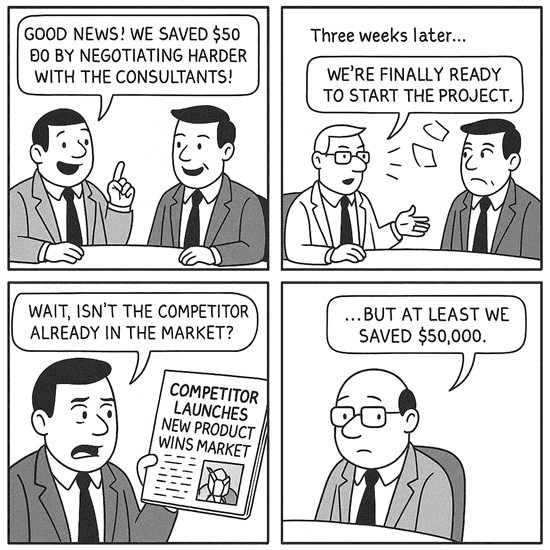
This is why two projects priced at the same $500,000 can feel completely different. One might run with minimal disruption, while another may drain hundreds of internal hours and delay a strategic initiative. The difference isn’t the price—it’s the intensity and the timing.
For executives, understanding these hidden costs is about protecting both bandwidth and strategic opportunities. For procurement, it’s about moving beyond day rates and proposals to assess the true total cost of ownership: consulting fees plus the internal workload plus the cost of lost time and missed opportunities.
2. Why Demand Management Can Make or Break Your Consulting ROI
The first lever of consulting cost management doesn’t lie in negotiations or contracts. It lies in deciding what projects to launch in the first place. This is the essence of demand management: making sure you do the right projects, with the right setup, and only once.
When organizations skip this discipline, hidden costs accumulate quickly. You end up buying the wrong support, duplicating past efforts, or burning resources on low-value initiatives. Let’s unpack the traps.
2.1. Make-or-Buy Without Strategy
At its core, demand management means asking: Should we do this in-house or bring in consultants?
- When companies over-buy: External consultants are hired for tasks the organization could have delivered internally. The hidden cost is not only inflated fees, but also missed opportunities to strengthen internal capability.
- When companies over-make: Conversely, internal teams are pushed to deliver complex, high-stakes work they aren’t equipped for. The result is slower delivery, rework, and sometimes the need to bring consultants in later anyway—paying twice for the same outcome.
Hidden Cost Insight: Without a structured make-or-buy framework, organizations bleed money either through unnecessary outsourcing or through costly internal failures.
2.2. Déjà Vu Consulting: Paying for the Same Work Twice (or Eight Times!)
Another common hidden cost is redoing work that has already been done.
In many companies, consulting projects happen in silos. Budgets are decentralized, knowledge isn’t shared, and no one has visibility on what’s already been delivered. The result? The same topic gets commissioned over and over again.
👉 Real story: one client launched eight separate “Future of Work” studies in the same year during COVID, each run by different units, with different consultants, and little to no cross-pollination. Not only was this an enormous waste of money, but the duplication also created confusion instead of clarity.
Hidden Cost Insight: Poor demand management means paying multiple times for the same PowerPoint, instead of capitalizing on institutional knowledge and building from a single foundation.
2.3. Bundling vs. Fragmentation: Structuring Demand for Value
Demand management is also about how projects are structured:
- Over-bundling: Mashing together unrelated projects just to gain scale leads to diluted quality—consultants may be strong in one area but weak in the other.
- Fragmentation: On the other end, when every department launches projects independently, you end up with duplicate scopes, inconsistent pricing, and missed opportunities for leverage.
Hidden Cost Insight: Smart bundling and central oversight save money by consolidating comparable work while avoiding the trap of “one-size-fits-all” bundles.
2.4. The ROI of Discipline
When demand management is done well, savings don’t just come from negotiating better rates. They come from avoiding unnecessary projects, eliminating duplication, and ensuring each consulting dollar is spent once, on the right initiative, with the right setup.
The equation is simple:
- Fewer redundant projects → direct cost savings.
- Better alignment of scope → higher impact.
- Consolidated budgets → stronger negotiating power.
Demand management isn’t a bureaucratic hurdle—it’s the foundation of consulting ROI.
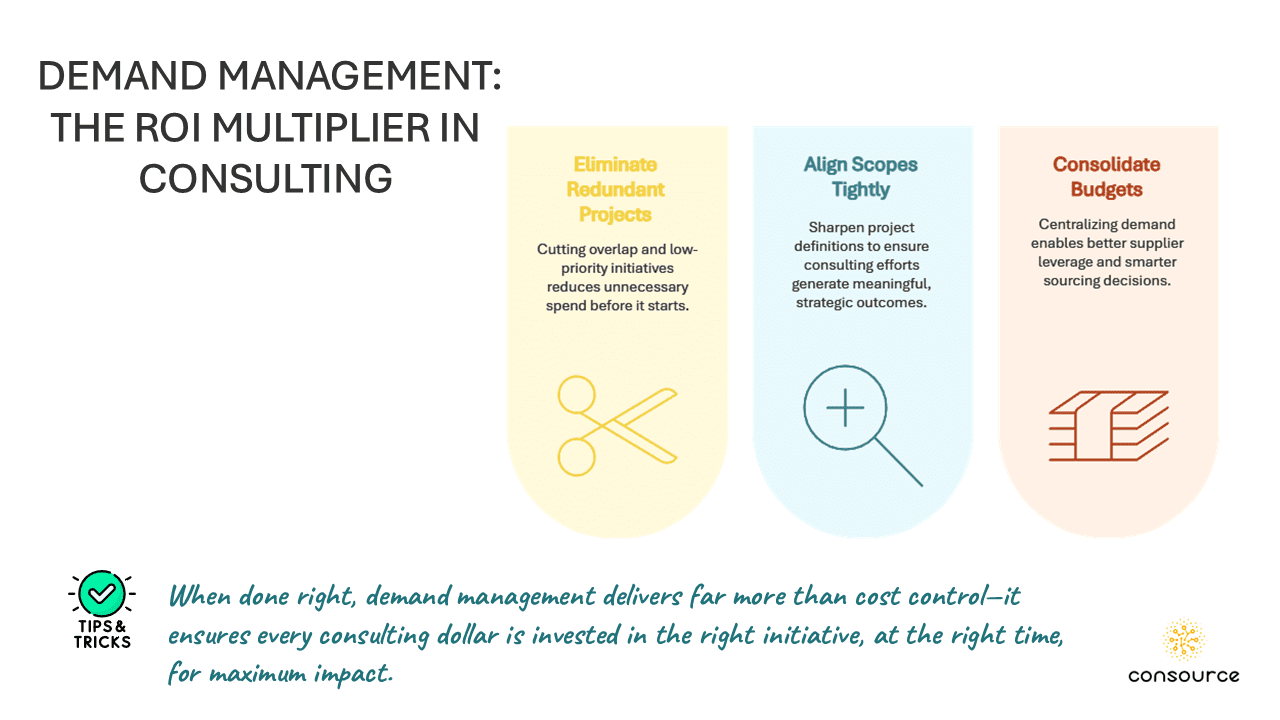
Key Takeaway
The first hidden costs in consulting don’t come from overpriced fees. They come from poor demand discipline: doing the wrong projects, doing them too many times, or structuring them badly. By professionalizing demand management, organizations ensure they invest in the right work, capture value once, and stop funding déjà vu consulting.
The Hidden Costs of a Flawed Buying Process
Once an organization decides that consulting is the right answer, the next step is to buy it right. This stage covers everything from defining the project scope, to writing and issuing the RFP, to selecting the right partner, and finally negotiating the contract.
On the surface, this looks like a structured process. In reality, it’s where some of the biggest hidden costs are locked in — sometimes without anyone realizing until much later.
3.1. Scoping: The Illusion of Alignment
Every consulting project begins with a scope, but too often, that scope is the product of compromise rather than clarity. Business leaders, procurement, and consultants each bring their own perspectives. If they’re not aligned upfront, costs explode later.
- Over-scoping: Adding every stakeholder’s wish list bloats the project, stretching timelines and requiring more consultants.
- Under-scoping: Omitting key dimensions because “we’ll figure it out later” leads to costly change orders mid-project.
- Moving target scope: When no one takes the time to align, consultants spend the first month clarifying expectations instead of delivering insights.
👉 Hidden Cost Example: A global bank defined a digital strategy project so vaguely that the consultants delivered a generic framework. Within six months, the same project had to be relaunched with a different firm. Total spend: 2x the original budget for the same output.
3.2. The RFP: Garbage In, Garbage Out
The RFP is supposed to articulate the client’s needs and invite consultants to propose tailored solutions. Instead, it’s often reduced to a formality.
- The copy-paste trap: Many RFPs are recycled templates. The result? Generic proposals that don’t address the real issue.
- The over-engineering trap: Some RFPs dictate the methodology so tightly that consultants can’t innovate. You get compliance, not creativity.
- The participation trap: Invite too many firms, and you drown in proposals; invite too few, and you kill competition.
👉 Hidden Cost Example: A manufacturer invited 12 firms to bid on an operational excellence program. The evaluation process took six weeks and drained 200+ hours of internal time — only for the CEO to push through his “preferred” supplier anyway. Cost of internal effort? Easily $100,000+ of executive time wasted.
3.3. Selection: When Politics Beat Value
The selection phase should be about choosing the best partner to deliver impact. In practice, politics and comfort often drive the decision.
- The brand bias: Choosing a Tier-1 firm “because the board will like it,” even if a boutique is better suited.
- The familiarity bias: Rehiring the same firm out of habit, even if they’ve under-delivered before.
- The pitch bias: Falling for a slick presentation rather than checking the actual delivery team’s track record.
👉 Hidden Cost Example: A Fortune 500 insurer hired a Tier-1 firm at premium rates for a post-merger integration. Most of the work was staffed with junior consultants. The client paid 40% more than a specialized boutique would have charged — and still had to rehire experts later to fix critical gaps.
3.4. Contracting: Locking in the Wrong Terms
The contract is where you formalize the partnership. But weak contracts are an open invitation to hidden costs.
- Vague Statements of Work (SOWs): If deliverables aren’t crystal clear, scope creep is inevitable.
- Paying for effort, not impact: Hourly or daily rate contracts without performance safeguards mean the client bears all the risk.
- Loose IP terms: If knowledge and frameworks stay with the consultant, you may end up paying again in the future for the same deliverables.
👉 Hidden Cost Example: One client realized too late that the consultant retained ownership of a “Future of Work” framework. When another division wanted to apply it, they had to re-hire the same firm — paying twice for the same project.
3.5. How to Buy Consulting Without Hidden Costs
Fixing the buying stage doesn’t mean slowing it down. It means putting rigor where it matters:
- Invest in alignment workshops to define a scope that reflects real needs, not politics.
- Craft RFPs that emphasize outcomes, not rigid methodologies.
- Evaluate based on fit and value, not just brand or familiarity.
- Write strong contracts that tie fees to deliverables, safeguard IP, and set clear governance rules.
When organizations skip these steps, they lock in hidden costs: wasted internal time, overpriced partners, generic deliverables, and rework that multiplies downstream.
Key Takeaway
From scope to contract, buying consulting is a high-stakes process. Done carelessly, it locks in inefficiencies that can cost millions. Done right, it ensures your consulting spend translates into impact, not invoices.
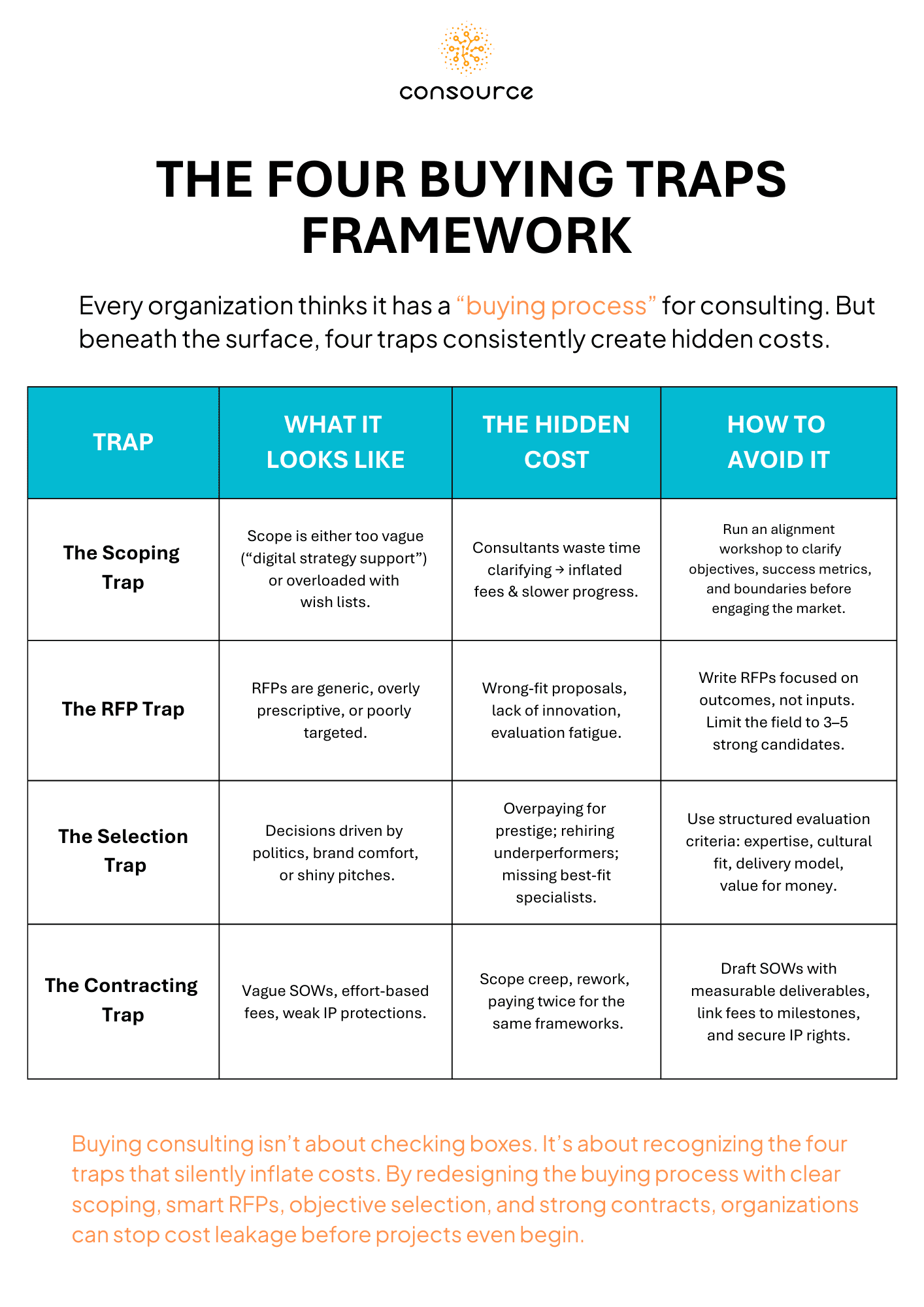
4. Managing Consulting Projects: Where Value Is Won or Lost
A consulting project doesn’t succeed just because you picked the right firm. The real work starts after the ink is dry. Yet this is precisely where most organizations stumble.
Some clients treat consultants like autopilot — “they’re the experts, they’ll figure it out.” Others go the opposite way and micromanage every deliverable, suffocating the project. Both approaches guarantee hidden costs. The sweet spot lies in structured governance that balances control with trust.
But even when projects are well-governed during execution, the final trap comes at the end: the consultant’s departure. If the transition isn’t planned, the investment quickly erodes.
4.1. The Cost of No Management at All
In many companies, once the consultants arrive, leaders disengage.
- No sponsor involvement: Without an active executive sponsor, consultants operate in a vacuum, chasing assumptions rather than driving impact.
- No stakeholder engagement: If business lines aren’t actively involved, recommendations lack ownership and often die in PowerPoint decks.
- No monitoring: Progress isn’t tracked, issues aren’t escalated, and by the time problems surface, they’re expensive to fix.
👉 Hidden Cost Example: A global pharma company hired consultants for a cost-reduction program. Without governance, the consultants recommended changes that conflicted with other ongoing initiatives. The result? Three months lost and $1M in sunk consulting fees for work that could never be implemented.
4.2. The Cost of Micromanagement
On the other end of the spectrum, some clients manage consultants as if they were internal analysts.
- Excessive approvals: Every slide, every draft has to pass multiple review layers.
- Shifting inputs: Leaders constantly “re-direct” the project, preventing momentum.
- Decision paralysis: Consultants wait for sign-offs instead of moving forward.
👉 Hidden Cost Example: A financial services firm staffed an internal “shadow team” to check every consultant’s deliverable. It doubled the workload, drained internal bandwidth, and extended the project timeline by 10 weeks. Savings achieved? None. Hidden cost: $2M in delayed implementation benefits.
4.3. The Intensity Burden: Counting Internal Workload
Every consulting project consumes internal time — workshops, interviews, data requests, steering committees. But few organizations ever budget for this.
- A “light” project might consume 200 hours of internal time.
- A “heavy” project can exceed 5,000 hours — the equivalent of several FTEs for a year.
The hidden cost isn’t just lost time. It’s the opportunity cost of managers pulled away from their day jobs. If your top sales leader spends 20% of her time feeding a consulting project, what’s the cost in missed revenue?
4.4. The Knowledge Leakage Problem
Consultants don’t just deliver recommendations — they generate insights, frameworks, and tools. Without proper management, this value evaporates.
- No institutionalization: Deliverables are stored, but never reused.
- Dependency loop: The same consultants are rehired later to re-explain their own work.
- Missed learning: Internal teams remain spectators rather than building new skills.
👉 Hidden Cost Example: One industrial group paid for a global market entry framework in 2019, failed to embed it, and re-bought the same framework from a different firm in 2022. Total hidden cost: paying twice for the same knowledge.
4.5. The Forgotten Exit: When Consultants Walk Out the Door
Most organizations focus on onboarding consultants — but neglect to prepare for their exit. This is where millions in hidden costs are lost.
- No knowledge transfer: Consultants leave with frameworks, data, and know-how that never gets absorbed by the client team.
- No ownership: Recommendations are presented, but no one is accountable for taking them forward.
- No practical action plan: The “what to do” is delivered, but not the “how to do it tomorrow morning.”
- Report-on-the-shelf syndrome: The deliverable looks impressive, but it isn’t implemented. It gathers dust until a new manager arrives, rediscovers the same issues, and commissions another consulting project to solve them.
👉 Hidden Cost Example: A global retailer spent millions on a customer experience strategy. No transition plan was made, and the consultants’ frameworks weren’t embedded. Three years later, with a new CMO, the company rehired another firm to “rethink customer experience.” Translation: they paid twice for the same strategy.
4.6. Finding the Balance: Structured, Not Suffocating
Good project management is about creating value during the project and ensuring that value lives on after the consultants are gone. That means:
- Active sponsorship to steer the work.
- Right-sized governance to keep scope, cost, and effort balanced.
- Defined roles so both consultants and client teams know who does what.
- Knowledge transfer plan embedded into deliverables.
- Transition ownership — clear accountability for who carries the project forward once the consultants leave.
Key Takeaway
The manage phase is where most consulting ROI evaporates — either through neglect, micromanagement, or failure to prepare for the consultants’ departure. The hidden costs aren’t just budget overruns. They are wasted knowledge, stalled initiatives, and the endless cycle of paying again for work that should have been institutionalized the first time.
5. The Work Behind the Work: Why Consulting Projects Drain More Than Your Budget
Most executives think consulting costs end with the invoice. But behind every project lies another dimension: the work your own teams must contribute. This “intensity factor” is shaped not only by the consultants’ way of working but also by how you design the scope and choose the delivery model.
5.1. Same Scope, Different Models
Here’s the catch: the same RFP can generate ten different proposals — all answering the same high-level objectives, but with very different delivery models:
- Advisory only: “We give you principles, you run with them.”
- Diagnose and recommend: Consultants analyze and propose, but implementation is yours.
- Collaborative model: Consultants and internal teams implement together.
- Full outsourcing: Consultants design and deliver end-to-end, while you stay hands-off.
Each of these can technically deliver the same project outcomes. But the price tag and the client workload are completely different.
5.2. The Double Filter: Budget and Bandwidth
That’s why choosing a consultant isn’t just about fees — it’s about matching the model to your organization’s capacity. Before you sign a contract, you need to ask two questions:
- Can we afford it? Do we have the budget to pay for the delivery model proposed?
- Do we have the bandwidth? Can we commit the people and time required to make this model work?
👉 Example: A strategy project priced at $500K could be run in “diagnose & recommend” mode, requiring heavy client involvement. The same project, outsourced to a full-service model, could cost $1M but demand almost no internal time. Both deliver the same strategy deck — but one might exhaust your teams, while the other drains your budget.
5.3. Prioritization Matters
Intensity isn’t just a resource issue. It’s also a question of strategic importance. If the project is a top priority aligned with your strategy, you may be willing to dedicate more internal bandwidth. If it’s peripheral, you may prefer a lighter model or defer it altogether.
👉 Hidden Cost Insight: Projects without strategic priority tend to suck resources and die halfway — consuming both money and internal goodwill.
5.4. Designing Intensity Proactively
The intensity of a consulting project should never be an accident. It should be designed as part of the sourcing and scoping process. That means:
- Asking consultants to present delivery model options with clear trade-offs (fees vs. internal workload).
- Evaluating proposals not only on cost and expertise, but also on organizational bandwidth.
- Aligning scope with strategy so resources aren’t wasted on “nice-to-have” projects.
Key Takeaway
Consulting projects don’t just cost money. They cost time, energy, and focus. The same scope can be delivered through multiple models — some heavier on fees, others heavier on client workload. Smart organizations design for intensity upfront, ensuring they can both afford the invoice and manage the burden, while keeping projects aligned with strategic priorities.
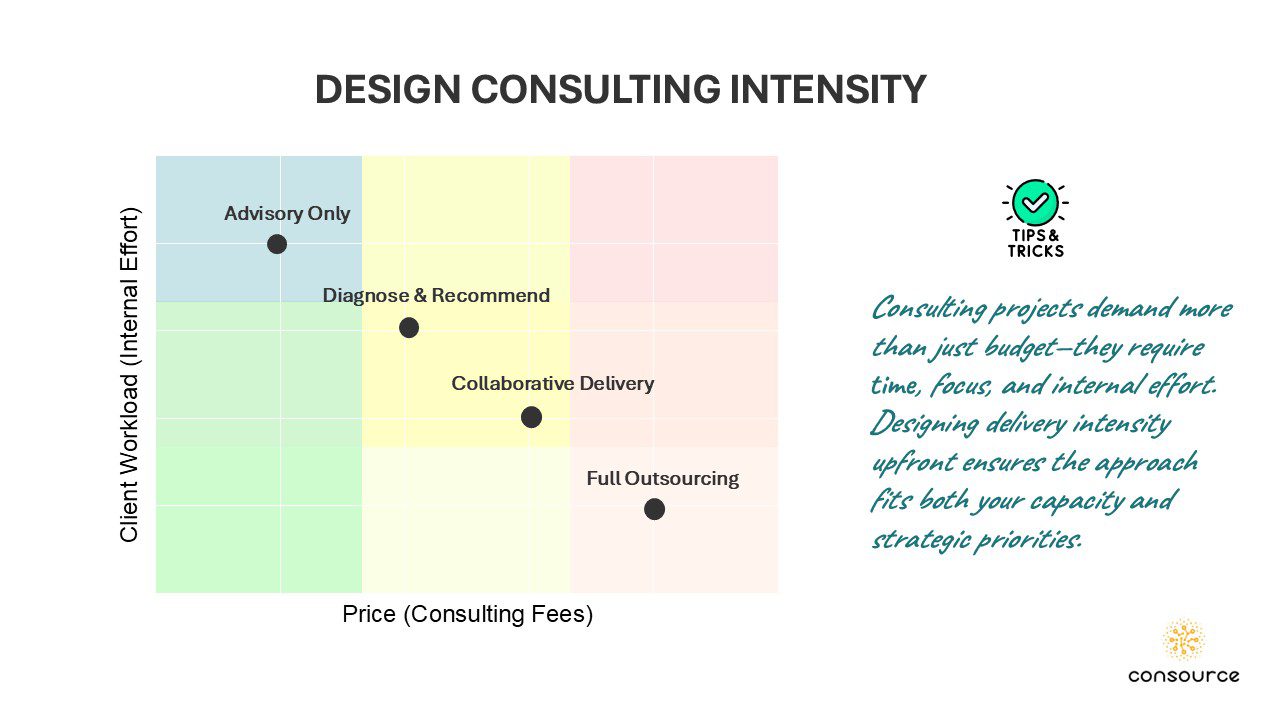
6. How to Anticipate and Control Hidden Costs
Controlling hidden costs isn’t about shaving a few points off day rates. It’s about building systematic practices that make sure consulting spend is directed at the right projects, managed in the right way, and turned into lasting value. Here’s how leading organizations do it:
6.1. Implement Strong Demand Management
Demand management is the first line of defense. You need to challenge projects, scopes, and suppliers before they enter the pipeline.
For a deeper dive into practical tactics on reducing consulting costs while maximizing value, check out this guide on how to reduce consulting costs smartly
- Test every project against strategic priorities — is it truly mission-critical?
- Capture duplicate projects early to avoid running the same work multiple times.
- Use bundling wisely to consolidate similar projects and gain leverage without diluting quality.
👉 Impact: You only fund the right projects, with the right scope, once.
6.2. Train Procurement on Consulting Procurement
Most procurement teams are skilled in categories like IT or marketing, but consulting is different. It’s intangible, people-based, and highly political. Without proper training, procurement can’t play its role as a value enabler.
- Train teams on consulting market dynamics and pricing models.
- Build capability in scoping, RFP writing, and partner evaluation.
- Provide tools and benchmarks so they can challenge suppliers effectively.
👉 Impact: Procurement moves from “cost police” to strategic advisor.
6.3. Train Stakeholders on Scoping and Project Management
Executives and business leaders initiate projects — but often without the skills to scope them clearly or manage them properly. That’s where hidden costs sneak in.
- Educate stakeholders on how to define outcomes, not just activities.
- Train them to manage consultants with balance: engaged but not micromanaging.
- Show them how to anticipate workload and resource it properly.
👉 Impact: Projects start with sharper scopes and are managed to deliver value, not frustration.
6.4. Make Workload and Price Transparency Mandatory in RFPs
Most RFPs focus only on fees. Few ask consultants to spell out the client workload required. That’s a mistake.
- Require a breakdown of fees, including expected FTEs by role.
- Ask consultants to estimate the internal effort they’ll need from your teams.
- Compare proposals not just on price, but on the intensity trade-off: what you pay vs. what you have to do.
👉 Impact: You avoid projects you can’t afford financially — or operationally.
6.5. Anticipate the Consultants’ Departure from the Start
The biggest leak of value comes when consultants walk out the door. If you don’t prepare for that moment, you’ll pay for the same work again in a few years.
- Build knowledge transfer requirements into your RFP and SOW.
- Make sure deliverables include practical action plans and internal training.
- Assign ownership of recommendations before consultants leave.
👉 Impact: You capture the value once — and keep it.
6.6. Capitalize on Deliverables to Avoid Duplication
Consulting projects generate reports, frameworks, and playbooks — but too often, they gather dust. The result? Different business units commission the same project again.
- Create a central repository of deliverables accessible across the organization.
- Institutionalize knowledge so future projects build on what was already done.
- Reuse frameworks and insights to reduce the scope (and cost) of new projects.
👉 Impact: You stop paying multiple times for the same ideas.
Key Takeaway
Hidden costs in consulting aren’t inevitable. With disciplined demand management, skilled procurement, trained stakeholders, transparent RFPs, prepared exits, and institutionalized deliverables, organizations can turn consulting from a cost center into a true investment engine.
Turning Hidden Costs into Lasting Value
Consulting projects are never just about the invoice. The real cost lies in the work behind the work — in projects launched without discipline, in vague scopes and weak contracts, in poorly managed delivery, in exhausting workloads, and in forgotten deliverables that force you to pay for the same project twice.
These hidden costs drain budgets, exhaust teams, and stall transformation. But they are not inevitable.
By taking a lifecycle approach — utilize → buy → manage — and by factoring in intensity, organizations can shift from reactive buying to proactive value creation. The practices are clear: challenge demand, professionalize procurement, train stakeholders, demand transparency in RFPs, prepare for consultant exits, and capitalize on deliverables.
Do this well, and consulting stops being an unpredictable expense. It becomes a strategic lever: a way to accelerate priorities, build capabilities, and generate lasting ROI.
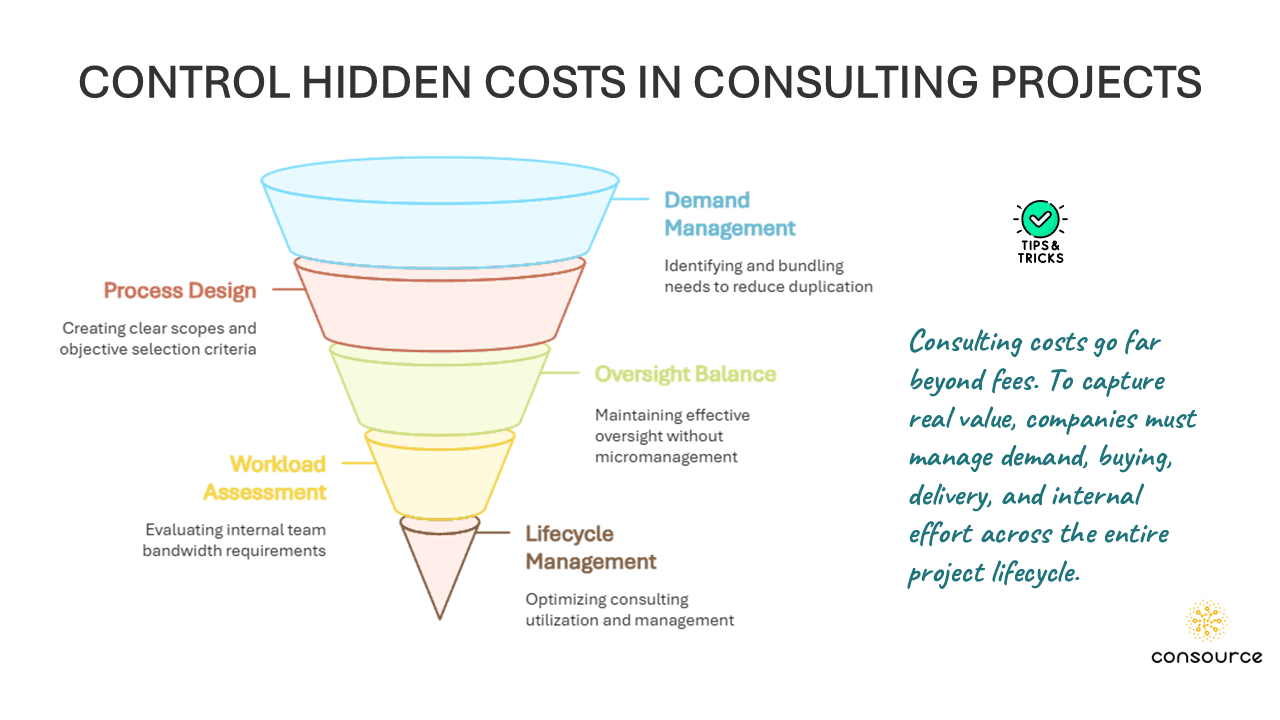
At Consource.io, we believe every dollar spent on consulting should deliver value that outlives the project. And we know how to help organizations get there.
If you’re ready to uncover the hidden costs in your consulting spend — and transform consulting into a true investment engine — book a free consultation call with our team. Let’s design a consulting sourcing strategy that saves money, protects your teams, and maximizes impact.
Book a free walkthrough of Consource.io Click here






0 Comments